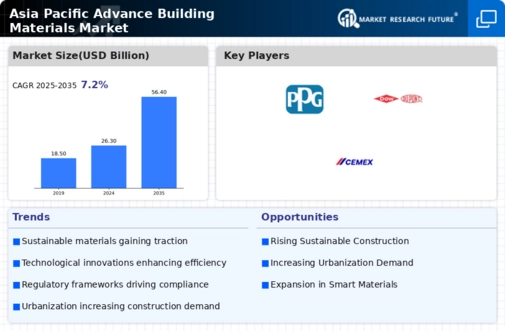Market Growth Projections
The Global Asia Pacific Advance Building Materials Market Industry is poised for substantial growth, with projections indicating a market size of 541.32 USD Billion by 2035. The anticipated compound annual growth rate of 7.84% from 2025 to 2035 suggests a robust expansion trajectory. This growth is driven by various factors, including urbanization, technological advancements, and increasing demand for sustainable materials. As the market evolves, stakeholders are likely to adapt to emerging trends and consumer preferences, positioning themselves strategically to capitalize on the opportunities presented by this dynamic industry.
Sustainable Construction Practices
The increasing emphasis on sustainable construction practices drives the Global Asia Pacific Advance Building Materials Market Industry. Governments across the region are implementing stringent regulations aimed at reducing carbon footprints and promoting eco-friendly materials. For instance, initiatives to use recycled materials and energy-efficient designs are gaining traction. This shift not only aligns with global sustainability goals but also appeals to environmentally conscious consumers. As a result, the market is projected to grow significantly, with a valuation of 235.94 USD Billion in 2024, reflecting the rising demand for sustainable building solutions.
Government Initiatives and Policies
Government initiatives and policies play a pivotal role in shaping the Global Asia Pacific Advance Building Materials Market Industry. Various countries are introducing incentives for the use of advanced materials in construction, such as tax breaks and subsidies. These policies aim to encourage innovation and the adoption of sustainable practices within the construction sector. Additionally, public-private partnerships are being formed to facilitate large-scale infrastructure projects, further stimulating demand for advanced building materials. The proactive stance of governments is likely to enhance market growth, contributing to the projected increase in market size over the coming years.
Technological Advancements in Materials
Technological advancements in building materials are reshaping the Global Asia Pacific Advance Building Materials Market Industry. Innovations such as smart materials, prefabrication techniques, and 3D printing are enhancing construction efficiency and reducing waste. These technologies allow for faster project completion and improved quality control, which are essential in meeting the demands of modern construction. As these advanced materials become more accessible, they are expected to capture a larger market share. The anticipated compound annual growth rate of 7.84% from 2025 to 2035 underscores the potential for growth driven by these technological innovations.
Urbanization and Infrastructure Development
Rapid urbanization in Asia Pacific is a crucial driver for the Global Asia Pacific Advance Building Materials Market Industry. As populations migrate to urban areas, there is an escalating need for housing, commercial spaces, and infrastructure. Governments are investing heavily in infrastructure projects, including roads, bridges, and public transport systems. This trend is expected to contribute to the market's growth, with projections indicating a market size of 541.32 USD Billion by 2035. The demand for advanced building materials that can withstand the rigors of urban environments is likely to increase, further propelling market expansion.
Growing Demand for Energy-Efficient Solutions
The growing demand for energy-efficient building solutions is a significant driver of the Global Asia Pacific Advance Building Materials Market Industry. As energy costs rise and environmental concerns mount, both consumers and builders are seeking materials that enhance energy efficiency. This trend is reflected in the increasing adoption of insulation materials, energy-efficient windows, and HVAC systems. The market's growth is expected to be robust, with a valuation of 235.94 USD Billion in 2024, as stakeholders prioritize energy-efficient designs in their projects. This focus on efficiency is likely to shape the future landscape of the building materials market.



 Source: Secondary Research, Primary Research, Market Research Future Database and Analyst Review
Source: Secondary Research, Primary Research, Market Research Future Database and Analyst Review










Leave a Comment